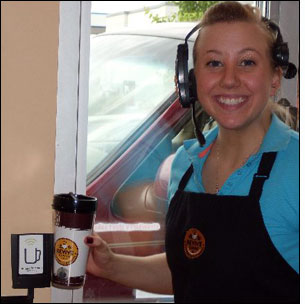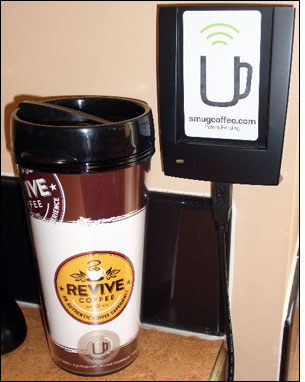In the interest of going green, customers at a handful of coffee houses are buying their beverages with reusable mugs known as Smugs (or Smart Mugs) with RFID chips embedded inside, thereby reducing not only the number of paper cups in landfills, but presumably the time they spend paying for drinks as well. The system was conceived and developed by Chris Hallberg when he was a coffee-drinking student at Marquette University, in Milwaukee, Wisc. He has since graduated, and now works in El Salvador developing nebulizers that can operate without electricity (nebulizers are used to transform liquid medication in a mist that can be inhaled into the lungs), thanks to funding from a research grant. Hallberg is also assisting the Ministry of Transportation in the city of San Salvador to develop an RFID-based prepaid transit card for city buses.
In 2008, while attending bioengineering classes, Hallberg envisioned an RFID-enabled coffee cup that customers could use to pay for beverages, by simply loading an account with funds and tapping the cup against a reader wired to a server containing data related to that account. He took the idea to several local coffee shops, eventually gaining the interest of Stone Creek Coffee. Hallberg began working with Stone Creek’s owner, Eric Resch, to develop a solution that would succeed in a typical coffee shop.

“We developed a prototype on my kitchen table,” Hallberg says, noting that the goal was to make the system as simple as possible. Although he had considered designing a reader specifically for the application—one that could connect directly to the Internet and be used at a standalone kiosk—he and Resch instead opted for an off-the-shelf reader that can plug directly into a computer or point-of-sale (POS) terminal and send tag-related information to the store’s back-end system, using software developed by Hallberg.
After Hallberg graduated in May 2009, he completed the system, which was then adopted in four coffee shops across the country: Revive Coffee, in Spokane, Wash.; Cedarburg Coffee Roastery, in two Milwaukee-area locations; and Coffee Shops, in Waterboro, Me. Stone Creek is not yet utilizing the system, because it is incompatible with its own POS system. However, he says, it plans to adopt a newer Internet-based version of the system next fall.
The Smug system employs a high-frequency (HF) 13.56 MHz circular RFID tag with a Mifare chip that can store a unique ID number linked to a customer’s account in the store’s software. The tag, approximately one and a half inches in diameter, is placed inside a double-walled travel mug, with a clear outer wall so that the tag, with a printed store logo and a printed ID number on the front, remains visible. Vision USA is manufacturing the mug, and is embedding the tag between the cup’s inner and outer walls.
Customers can purchase the Smug at a participating coffee shop, where they can load money (typically $20 or $30) into an account. Data related to that account is stored on the shop’s back-end system, and includes the amount of the deposit and balance, as well as the consumer’s name and contact information. An RFID reader with an integrated antenna is typically mounted to the wall, wired to the store’s computer-based POS system. When the Smug is moved to within a few centimeters of the reader, the device captures its tag’s unique ID number and forwards that information to the back-end system.
At Revive, customers can use the mugs to gain loyalty points, as well as pay for individual drinks. The store offers a 15-cent discount on every purchase made with a Smug, and sells the cups for $15 apiece, with a $5 balance preloaded onto the patron’s account. When the mug is first purchased, its tag is read at one of two Smug readers (one is located at the shop’s drive-through window, the other at a counter within the store). Staff members then input the individual’s name, contact information and deposit amount into the store’s software. Every dollar spent with the Smug equals one point, and 20 points grants the user a free 12-ounce drink. The mug can also be utilized as a gift card that a customer could purchase for someone else.
When a customer taps his or her Smug mug against the in-store reader, or when an employee does so at the drive-through window, the patron’s name, as well as a record of his or her previous purchases, is displayed on the POS screen. In that way, says Lauren Somers, one of Revive’s store managers, the consumer can also receive more personalized service, since it helps the staff learn the names of regular customers, and also makes it possible for shoppers to request “the usual” or “what I was drinking last time I was here.”
Since December 2009, several dozen Waterways customers have been using a Smug mug. The system is still perceived as something of a gimmick, says Waterways’ owner, Edward Wood, though he adds, “It’s working out fine.” In this case, customers can pay for their coffee and accumulate loyalty points. What’s more, he adds, when using the mug, patrons are charged for a drink one size smaller than the actual beverage purchased.
“People are still trying to understand the concept,” Somers states. “When we explain the mug has a built-in gift card and you just scan the mug, they say ‘What do you mean’?” However, she says, as more customers use the system—and as others watch them do so—the system is gaining popularity.
When Hallberg returns to Milwaukee this fall, he intends to dedicate his time to completing the next phase of the Smug system, whereby his company, Smug Coffee LLC, will host the back-end and user applications via Smug’s Web site. When this system goes live, he notes, consumers will be able to use any Internet-connected computer to log onto mysmug.com and launch an account for a specific store or stores. Consumers could log in, for example, to check account balances, add money or purchase a mug as a gift. The stores, primarily small independent coffee shops with Web-based cash-register systems, will be able to log onto Smug’s Web site to process a customer’s Smug-related coffee purchases.
Hallberg is not the only person looking to incorporate RFID into coffee mugs. Betacup, a campaign dedicated to eliminating the consumption of paper cups, recently held an online competition in search of the best ideas to accomplish its mission (Starbucks is one of Betacup’s sponsors). Several of the submitted entries proposed RFID-based solutions. One runner-up, he says, was “the Band of Honor”—a small, RFID-embedded elastic band that could be placed around a customer’s favorite mug, and operate as a loyalty card or payment system.


